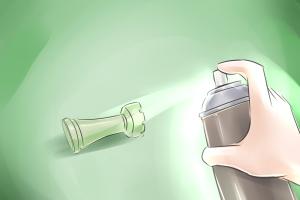Transform Your Brass: The Ultimate Guide on How to Patina Brass

-
Quick Links:
- 1. Introduction
- 2. Understanding Brass
- 3. Why Patina Brass?
- 4. Patina Brass Methods
- 5. Step-by-Step Guide to Patina Brass
- 6. Case Studies
- 7. Expert Insights
- 8. FAQs
1. Introduction
Brass, a beautiful amalgamation of copper and zinc, has long been cherished for its warm, golden hue and versatility. Over time, the quest for a vintage look has led many to explore the art of patina. This guide will delve into the fascinating world of patina brass, revealing methods, techniques, and the science behind aging brass to achieve stunning results.
2. Understanding Brass
Brass is an alloy primarily composed of copper and zinc, with varying proportions that affect its color, strength, and workability. The unique properties of brass make it an ideal candidate for various applications, from musical instruments to decorative items. Understanding the composition of brass can significantly enhance your approach to patina techniques.
3. Why Patina Brass?
Patina adds depth and character to brass items, enhancing their aesthetic appeal. Here are a few reasons to consider patina brass:
- Artistic Expression: Patina allows for creative expression, transforming ordinary brass into one-of-a-kind pieces.
- Historical Significance: Aging brass can give items a sense of history and authenticity.
- Protection: A patina layer can act as a protective barrier, preventing further corrosion.
4. Patina Brass Methods
There are various methods to achieve a patina effect on brass, each with unique characteristics. Below, we explore three primary techniques:
4.1 Natural Patina
Natural patina occurs over time due to exposure to environmental elements. This process can be accelerated by:
- Exposure to moisture
- Application of vinegar or saltwater
- Use of acidic substances like lemon juice
4.2 Chemical Patina
Chemical methods involve using specific solutions to create a desired patina effect. Common chemicals include:
- Ammonium Chloride: Creates a greenish patina.
- Hydrogen Peroxide: Achieves a dark, aged look.
4.3 Heat Patina
Applying heat to brass can create stunning colors ranging from deep blues to rich browns. This method requires caution and the right equipment:
- Use a propane torch for controlled heating.
- Monitor the heating process closely to avoid damage.
5. Step-by-Step Guide to Patina Brass
Below is a comprehensive guide to patina brass using the chemical method:
Materials Required:
- Brass item
- Ammonium Chloride solution
- Water
- Protective gloves
- Brush
- Container for soaking
Step 1: Prepare the Brass Item
Clean the surface of the brass item using soap and water. Rinse thoroughly and allow it to dry completely.
Step 2: Prepare the Patina Solution
Mix ammonium chloride with warm water in a container according to package instructions. Ensure the mixture is well combined.
Step 3: Apply the Solution
Using a brush, apply the ammonium chloride solution to the brass item. Ensure an even coating for consistent results.
Step 4: Allow to Patina
Let the item sit for several hours, checking periodically for the desired color. Rinse the brass item with clean water after achieving the preferred patina.
Step 5: Seal the Patina
Once dried, consider applying a clear lacquer to preserve the patina effect. This step is crucial for maintaining the appearance over time.
6. Case Studies
Let’s explore a few fascinating case studies where artists and craftsmen have successfully patinated brass:
- Artisan Lamp Maker: A local artist used heat patina to create a unique lamp, showcasing varying hues of blue and green.
- Restoration of Antique Hardware: A restoration expert applied a natural patina method to antique handles, preserving their history while enhancing their beauty.
7. Expert Insights
We consulted expert metalworkers and artisans to gather insights on best practices for patina brass. Here are key takeaways:
- Always wear protective gear when working with chemicals.
- Experiment with small pieces to test your methods before applying them to larger items.
- Patience is essential; allow time for the patina to develop naturally.
8. FAQs
1. What is patina?
Patina is a surface appearance that develops on metals, particularly brass, due to oxidation and other environmental factors.
2. How long does it take for brass to develop a natural patina?
The time can vary from weeks to years, depending on environmental conditions such as humidity and exposure to air.
3. Can I remove patina from brass?
Yes, using a brass cleaner or polishing compound can remove patina if you desire a shiny finish.
4. Is patina permanent?
Patina can fade or change over time, but sealing it with lacquer can help preserve its appearance.
5. What safety precautions should I take when patina brass?
Always wear gloves, protective eyewear, and ensure proper ventilation when working with chemicals.
6. Can I patina brass items indoors?
While you can, ensure good ventilation and consider performing the process outdoors to minimize inhalation of fumes.
7. What type of brass is best for patina?
Brass with higher copper content generally develops a more vibrant patina.
8. How do I maintain my patinaed brass?
Regular dusting and avoiding harsh chemicals will help maintain the patina. Consider applying a protective coating periodically.
9. Can I use household items to patina brass?
Yes, substances like vinegar and salt can be effective for creating a patina effect.
10. What are some popular patina colors for brass?
Popular colors include green, blue, and brown, each achieved through different methods.
Random Reads
- How to install hackers keyboard android
- How to tag someone on whatsapp android
- How to take a screenshot
- How to disable avg
- How to add comment in microsoft word
- Convert pdf to jpeg
- Convert wordperfect to ms word
- Discovering the yoshi kids paper mario
- How you can still use windows photo gallery today
- How to make a dnd character